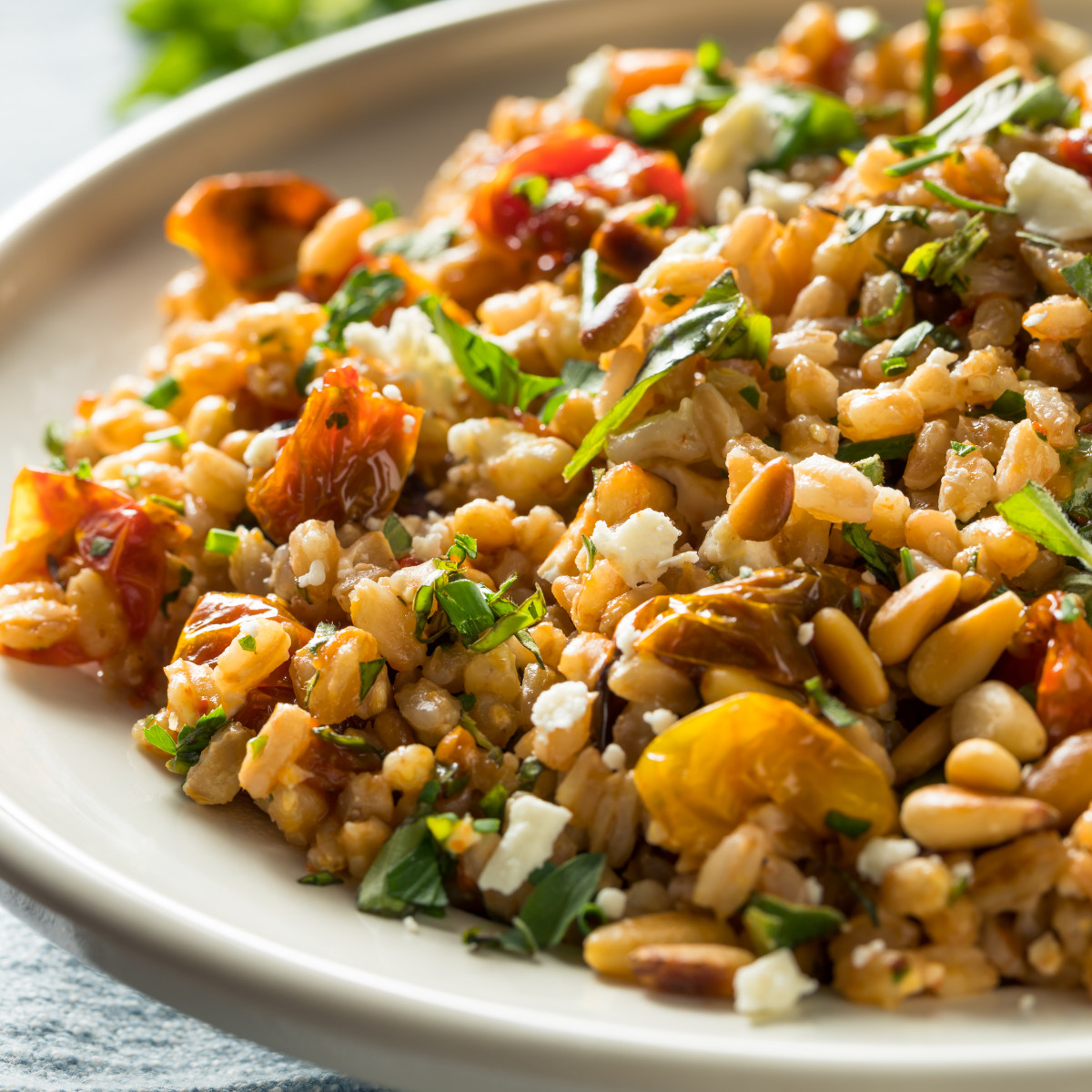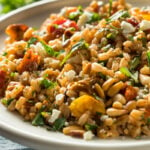You’ve likely heard before that whole grains are good for you. But what exactly is a whole grain? And what are their health benefits? Learn more below about how the quality of the carbohydrates we eat matters.

What are Whole Grains?
Whole grains are the natural form in which grains are harvested before processing. The grain contains three parts to each kernel– the bran, germ, and endosperm.
- The bran is the outer layer of the grain, and it contains most of the grain’s fiber. It also provides B vitamins, minerals, and antioxidants.
- The germ is a small inner portion that helps the grain grow new plants and is a good source of fats and vitamin E.
- The endosperm makes up the bulk of the inner grain. It primarily contains carbohydrates along with some vitamins and minerals (1, 2).
All three of these components must still be intact for a grain to be considered a whole grain (2). Examples of whole grains include brown rice, barley, oatmeal, and whole wheat bread.
Whole Grains vs. Refined Grains
Many grains are milled to remove the bran and germ, leaving only the endosperm. This results in a refined grain. Examples of refined grains include white bread, white rice, and white pasta.
Since the bran and germ contain protein, fiber, vitamins, and minerals, the refined grain is lower in nutrients and fiber (2).
Due to the loss of nutrients during processing, many refined grains are now “enriched” with important vitamins and minerals. This is done in an effort to improve the nutritional quality of the grains, though enriched grains don’t have as many nutrients as whole grains (2).
Refined grains are popular because they are affordable, accessible, and shelf stable. In addition, they require less cooking time, and many people prefer the taste and texture (1).
Whole Grain vs. Whole Wheat
You may have seen lots of different terms labeling whole grain products in the grocery store- “whole wheat,” “multigrain,” “contains whole grains,” but what’s the difference?
Whole grain is the umbrella term for any grain that is unprocessed and in its natural form. This includes wheat and non wheat grains, like oats and rice. Whole wheat is simply a term used to describe unprocessed wheat– essentially whole grain wheat (2).
Multigrain describes grain products that contain more than one type of grain. For example, multigrain bread may have enriched white flour and whole wheat flour. Similarly, products can be labeled as “contains whole grains,” which means that only a portion of the food is made with whole grains.
This marketing can make it confusing to shop for whole grain products. You can use two strategies to identify if a product is completely whole grain.
First, look for claims on the food packaging stating “100% whole grain.” You may see this on a bread, cracker, or breakfast cereal box. You’ll find the whole grain stamp on many packages– a yellow rectangular graphic that tells how much whole grain is in a product (1).
If this claim is not listed, you can look at the ingredient list on the nutrition label. Look for whole grains as the first ingredient, and ensure no refined grains are on the list, like enriched white flour (1).
5 Health Benefits of Whole Grains
Whole grains are packed with beneficial nutrients like fiber, vitamins, minerals, antioxidants, and phytochemicals. A diet rich in whole grains is known to help reduce the risk of heart disease, type 2 diabetes, and cancer while reducing inflammation and improving digestion (1).
But how many whole grains should you eat daily to reap these health benefits? The Dietary Guidelines for Americans recommend individuals consume at least half of their grains in the form of whole grains (3).
Most adults need 6-10 servings of grains daily, so aim for at least 3-5 servings of whole grains. One serving of whole grains is equivalent to one ounce (one slice of bread or ½ cup of cooked grain like rice or pasta). One ounce contains 15 grams of whole grains (4).
Heart Disease
Studies have found that the dietary fiber in whole grains is associated with a reduced risk of developing heart disease. Eating 2.5 servings of whole grains daily can reduce the incidence of heart disease by up to 37% (5).
Whole grains have other benefits for heart health. Eating 28-30 grams of whole grains per day (or around two 1-ounce servings) can help lower cholesterol levels. This is due to whole grains’ soluble fiber and phytosterol content, both of which help bind and eliminate cholesterol from the digestive tract (5).
In addition, the phytochemicals, or beneficial plant compounds, in whole grains can help lower blood pressure, which reduces the risk of stroke (5).
Type 2 Diabetes
Research shows that eating 2-3 servings of whole grains every day significantly lowers the risk of type 2 diabetes. In addition, just 1.5 servings of whole grains daily has been shown to lower blood glucose and insulin levels (5).
This benefit is likely related to the insoluble fiber in whole grains. This type of fiber can slow the rate of digestion, which helps keep blood sugar stable and prevent spikes.
In addition, some of the micronutrients present in whole grains, like chromium and magnesium, are known to have blood sugar-lowering benefits (5).
Digestion
Whole grains are fiber-rich, which can help with digestive health by improving constipation and increasing healthy gut bacteria (6).
A long-term high fiber diet has been shown to reduce the risk of developing inflammatory bowel diseases like Crohn’s disease (7).
However, whole grain foods may not be best in large amounts for people who already have gastrointestinal conditions. For example, those with Crohn’s disease or IBS may struggle with tolerating the fiber in whole grains and may need to limit their intake.
People with celiac disease, gluten sensitivity, or a wheat allergy need to be cautious around whole grains because many contain wheat and gluten.
Inflammation
Whole grains have been shown to reduce markers of inflammation in the body. This has been studied particularly in people at risk of developing metabolic syndrome (8, 9).
Chronic inflammation can contribute to a number of diseases, like diabetes and rheumatoid arthritis. One study looked at deaths from inflammatory diseases and found that women with the highest whole grain intake had a 35% reduced risk of mortality from inflammatory conditions (10).
Cancer
A diet rich in whole grains may reduce the risk of certain types of cancers. When compared to people with minimal intakes of whole grains, people who ate more whole grains had lower rates of colorectal, gastric, and pancreatic cancer (5).
This reduced risk is thought to be due to the polyphenols, antioxidants, and minerals found in whole grains (5). More research is needed to better understand this link.
Common Whole Grains
You may be wondering which grains are classified as whole grains. Below is a list of common whole grains (2). Keep in mind the healthiest whole grains are ones that are minimally processed.
Products made from whole grain flour, like crackers, bread, and pasta can be great ways to increase whole grain intake. Try to choose products with limited added sugars and salt to maximize the health benefits of whole grains.
Quinoa
Eaten by the ancient Incas, quinoa is another pseudo grain known for its small, round, and fluffy kernels.
Rice
Whole grain rice comes in many colors- brown, black, red, and many more. Wild rice is considered a whole grain. Look for whole grain versions of basmati and jasmine rice as well.
Healthy Whole Grain Farro Salad
Equipment
- 1 large mixing bowl
- 1 small mixing bowl
- 1 baking sheet
- parchment paper
Ingredients
- 1 cup farro
- 2 cups water
- 1/2 tsp salt
- 1 pint cherry tomatoes
- 1/4 cup fresh basil chopped
- 1/4 cup fresh parsley chopped
- 1/4 cup fresh mint chopped
- 2 tbsp extra virgin olive oil
- 1 tbsp red wine vinegar
- 3 cloves garlic minced
- salt and pepper to taste
Instructions
- Rinse the farro and drain it. Add it to a medium-sized saucepan with 2 cups of water and 1/2 teaspoon of salt. Bring to a boil, then reduce heat to a simmer and cook for 25-30 minutes, or until the farro is tender but still chewy. Drain off any excess water.
- While the farro is cooking, place the cherry tomatoes on a parchment-lined baking sheet and broil for 5-7 minutes, or until they burst and release their juices. Set aside to cool.
- In a large mixing bowl, combine the cooked farro, burst cherry tomatoes, chopped basil, parsley, and mint.
- In a small mixing bowl, whisk together the olive oil, red wine vinegar, minced garlic, salt, and pepper to make the dressing.
- Pour the dressing over the farro salad and toss until everything is well coated.
- Chill the salad in the refrigerator for at least 30 minutes before serving, to allow the flavors to meld together.







